
Legalized Marijuana: Canada Comes Round to the Wisdom of Ages
In 1997, a hemp rope dating back to 26,900 BC was found in Czechoslovakia, making it the oldest known object to be associated with marijuana. Since that time, hemp has played an important role in humanity’s development. For thousands of years marijuana was not only legal, but an important crop among cultures throughout history, and held commercial, medicinal, and spiritual value. Today, possession and recreational use of marijuana in Canada has been made legal, reports the BBC. It is only the second country, after Uruguay in 2013, to return the drug to this legal status after almost a century of controls and prohibitions. With many modern minds coming around to the uses of the plant (a Nanos poll found 70% of Canadians to be in favor of legalization) and evidence of it being used in medicines around the world for thousands of years, one wonders why it ever became deemed such a poison.

Cannabis sativa plant (Wikimedia Commons)
The cultivation of cannabis, commonly known as marijuana, can be traced back at least 12,000 years, which places the plant among humanity's oldest cultivated crops. Cannabis plants are believed to have evolved in Central Asia in the regions of Mongolia and southern Siberia. The earliest cultural evidence of Cannabis comes from the oldest known Neolithic culture in China, the Yangshao, who appeared along the Yellow River valley. From 5,000 to 3,000 B.C the economy of the Yangshao was cannabis-driven. Archaeological evidence shows they wore hemp clothing, wove hemp, and produced hemp pottery.
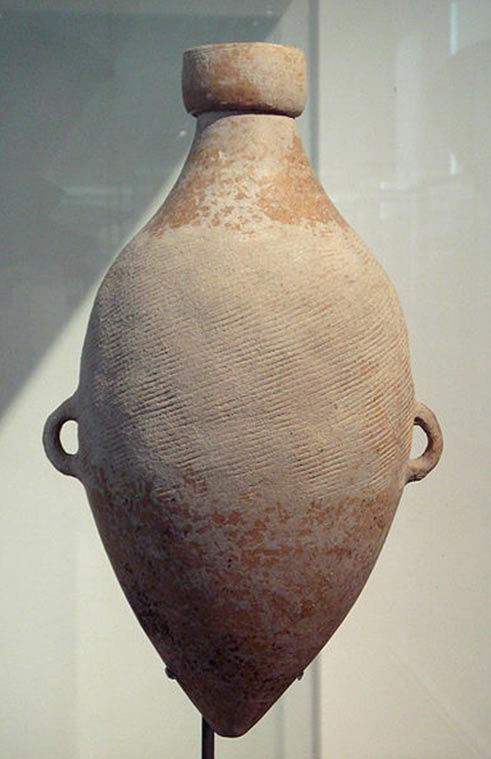
Yangshao hemp cord-marked amphora, 4800 BC, Shaanxi (Wikimedia Commons)
The first recorded use of marijuana as a medicinal drug occurred in 2737 BC by the Chinese emperor Shen Nung. He documented the drug’s effectiveness in treating the pains of rheumatism and gout. Both hemp and psychoactive marijuana were widely used in ancient China. The ancient Chinese used virtually every part of the Cannabis plant: the root for medicine; the stem for textiles, rope and paper making; the leaves and flowers for intoxication and medicine; and the seeds for food and oil. Cannabis seeds were also one of the grains of early China and ancient tombs of China had sacrificial vessels filled with hemp for the afterlife.
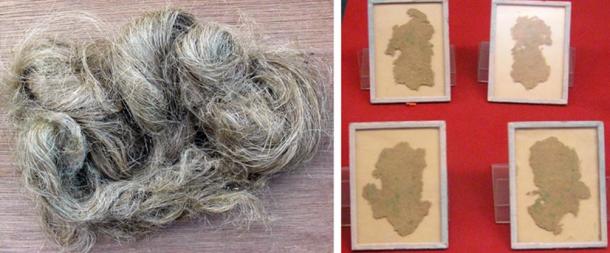
Left: Hemp fiber from the Cannabis sativa plant (Wikimedia Commons). Right: Chinese hemp fiber paper, used for wrapping not writing, excavated from the Han Tomb of Wu Di (140-87 BC) at Xi'An (Wikimedia Commons)
The first medical journals in China were made of hemp and eventually it came to replace papyrus as the source of paper that eventually fostered the spread of written knowledge. It was used to record the deeds of history, eventually replacing clay tablets and expensive silk to be read by everyone.
From China, coastal farmers took marijuana to Korea around 2000 B.C. or earlier. It reached India between 2000 B.C. and 1000 B.C., when the region was invaded by the Aryans, a group that spoke an archaic Indo-European language. They called cannabis “bhang.” In India, the Aryan religion grew through oral tradition and was recorded in the four Vedas, or books of knowledge compiled between 1400 and 1000 B.C. They worshipped the spirits of plants and animals, and marijuana played an active role in their rituals. Like the Chinese, the people of India have a long history of using hemp in their clothing and medicine.

Wild cannabis growing in Uttarakhand, India (Wikimedia Commons)
Cannabis use in ancient Egypt has been recorded as far back as 2,000 B.C., found on scrolls depicting medicinal plants. It was first documented in Kemet (ancient Egypt) to treat sore eyes and cataracts. According to Diodorus Siculus, a Sicilian Greek historian, Egyptian women used cannabis as a medication to relieve sorrow and bad humor. In 1213 B.C. Cannabis pollen was found on the mummy of Rameses II. Additional research has linked cannabis pollen to all known royal mummies.
- Prehistoric people used hallucinogens as part of sacred burial rituals
- New study sheds light on drug culture in Tiwanaku, Bolivia
- Ancient Healing Methods Offer an Alternative Paradigm in Health
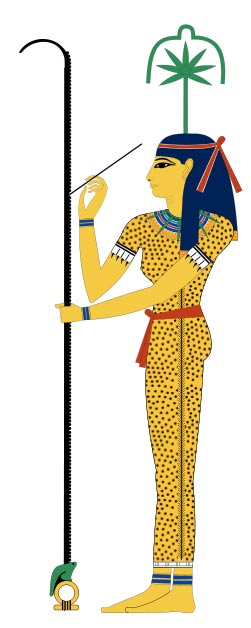
Seshat, the ancient Egyptian goddess of record-keeping and measurement. On her head is a cannabis leaf and flower. (Wikimedia Commons)
Marijuana was introduced to the Middle East between 2000 B.C. and 1400 B.C., where it was probably used by the Scythians, a nomadic Indo-European group. The medical use of the plant in the middle east is recorded in 700 B.C. in the Venidad, an ancient Persian religious text purportedly written by Zoroaster.
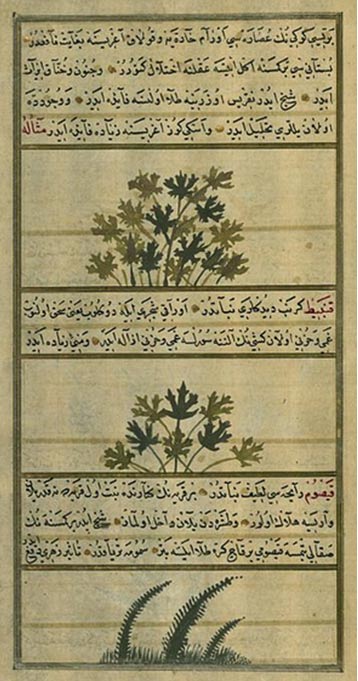
Manuscript Illustration of Hemp, Cauliflower, and Southernwood (Wikimedia Commons)
The Scythians brought Cannabis to Europe from the Altai Mountains to Germany around 2,800 years ago.
The Greeks make mention of it as a remedy for earache, edema, and inflammation in 200 B.C.
From there marijuana went to Britain during the 5th century Anglo-Saxon invasions.

Cannabis sativa, as seen in the Grandes Heures of Anne of Bretagne, (1505-1508). Here we have probably the most ancient botanic depiction of the plant in the western world (male and female). (Wikimedia Commons)
The Spanish brought marijuana to the Americas in the mid-1500s and the English introduced it at Jamestown in 1611, where it became a popular commercial crop alongside tobacco.
In 1799, Napoleon brought marijuana back to France from Egypt where it was investigated for its pain relieving and sedative qualities.
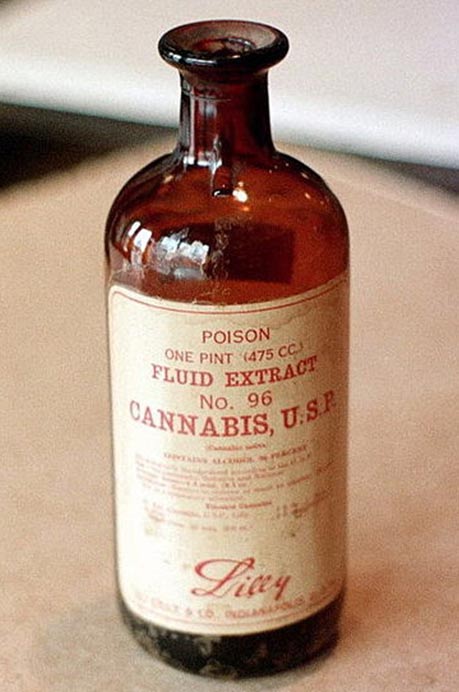
Cannabis as medicine (Wikimedia Commons)
Cannabis finally reached the United States at the beginning of the 20th century, arriving in the southwest from Mexico, as immigrants fled the country during the Mexican Revolution of 1910-1911. Beginning in the early 1900's, a number of state and local laws in the United States began prohibiting the use of marijuana. A federal law called the Marijuana Tax Act banned its use and sales in 1937. Prior to 1937 in the United States (and 1928 in the United Kingdom), cannabis had enjoyed a 5,000 year run as a therapeutic plant with no history of illegality.
In Canada, cannabis was restriced in 1923, when it was referenced as a ‘new drug’ and was one of 3 to be hurriedly added on to the ‘Act to Prohibit the Improper Use of Opium and other Drugs’. It was practically unheard of in the country at this time, and did not really become popular until the 1960s when convictions for its use increased dramatically. In Canada ‘medical marijuana’ was legalized in 2001, the UK government has just announced presribed cannibis for medical use will be available to doctors from November 1. It seems the controlling powers of the world might be slowly coming to appreciate the positive rather than negative effects of this ancient aid.
Top image: Canada legalizes marijuana concept. Source: freshidea via Fotolia
References
Blaszczak, By. "Marijuana's History: How One Plant Spread Through the World." LiveScience. October 17, 2014. Accessed May 16, 2015. http://www.livescience.com/48337-marijuana-history-how-cannabis-travelled-world.html.
Elliott, Steve. "Worth Repeating: Humans Discover Hemp, 10,000 B.C." Toke of the Town. July 19, 2011. Accessed May 16, 2015. http://www.tokeofthetown.com/2011/07/worth_repeating_humans_discover_hemp_10000_bc.php.
Frank, Mel. "Cannabis and Ancient History." Cannabis and Ancient History. 1978. Accessed May 16, 2015. http://www.walnet.org/rosebud/ancienthistory.html.
"The Tantra-Cannabis Connection- Origins and Implications." The Tantra-Cannabis Connection- Origins and Implications. Accessed May 16, 2015. http://real-gaia.angelfire.com/charas.html.
"Industrial Hemp Fibre." Accessed May 16, 2015. http://hashmuseum.com/industrial-hemp/industrial-hemp-fibre.
"Cannabis in Egypt." Sensi Seeds English Blog. December 27, 2013. Accessed May 16, 2015. http://sensiseeds.com/en/blog/cannabis-egypt/.
"Cannabis." Goddess Plan Pr Ntr Kmt. Accessed May 16, 2015. http://www.prntrkmt.org/herbs/cannabis.html.
Burnett, Malik. "How Did Marijuana Become Illegal in the First Place?" Drug Policy Alliance. October 9, 2014. Accessed May 16, 2015. http://www.drugpolicy.org/blog/how-did-marijuana-become-illegal-first-place.
"DEA / Drug Scheduling." DEA / Drug Scheduling. Accessed May 16, 2015. http://www.dea.gov/druginfo/ds.shtml.
















Comments
Go for it. You have my permission
Can I use your content for my website
Prohibition had one effect that is not addressed here, tens of thousands of people convicted of simple posession that clog our prison systems, especially in places like Lousiana. County sherrifs there get rich running warehouse prisons filled with over-flow prisoners from the state. Conditions in those places are not much better than prisons in third world countries, and the majority of people held in those facilities are convicted of non-violent offenses, such as simple possession.
Sorry, guess this is not an appropriate forum for that discussion. I apologize if I offended anyone, but stand by what I said.
Add the word “former” to Czechoslovakia and the sentence works fine. Even today, I still hear people refer to the old Czech Republic this day. Doesn’t seem very interesting or a big deal to me at all.
Just one big mistake ... in 1997 was no Czechoslovakia. Very interesting, that you are able check information from 2000 B.C., but not 20 years ago.
Pages